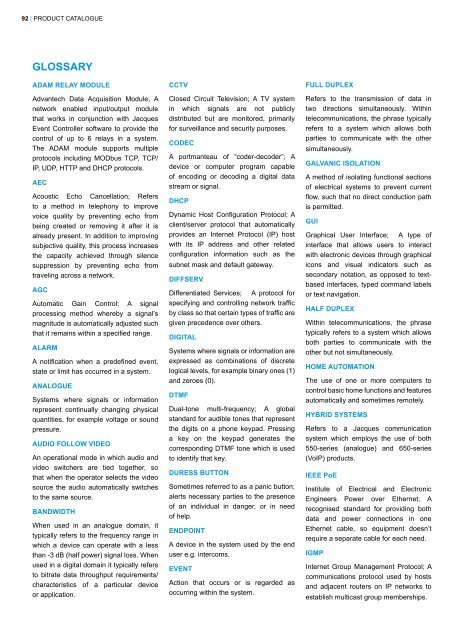Product Catalogue | 2015
You also want an ePaper? Increase the reach of your titles
YUMPU automatically turns print PDFs into web optimized ePapers that Google loves.
92 | PRODUCT CATALOGUE GLOSSARY | 93<br />
GLOSSARY<br />
ADAM RELAY MODULE<br />
CCTV<br />
FULL DUPLEX<br />
IP<br />
PTT<br />
SIP<br />
Advantech Data Acquisition Module; A<br />
network enabled input/output module<br />
that works in conjunction with Jacques<br />
Event Controller software to provide the<br />
control of up to 6 relays in a system.<br />
The ADAM module supports multiple<br />
protocols including MODbus TCP, TCP/<br />
IP, UDP, HTTP and DHCP protocols.<br />
AEC<br />
Acoustic Echo Cancellation; Refers<br />
to a method in telephony to improve<br />
voice quality by preventing echo from<br />
being created or removing it after it is<br />
already present. In addition to improving<br />
subjective quality, this process increases<br />
the capacity achieved through silence<br />
suppression by preventing echo from<br />
traveling across a network.<br />
AGC<br />
Automatic Gain Control; A signal<br />
processing method whereby a signal’s<br />
magnitude is automatically adjusted such<br />
that it remains within a specified range.<br />
ALARM<br />
A notification when a predefined event,<br />
state or limit has occurred in a system.<br />
ANALOGUE<br />
Systems where signals or information<br />
represent continually changing physical<br />
quantities, for example voltage or sound<br />
pressure.<br />
AUDIO FOLLOW VIDEO<br />
An operational mode in which audio and<br />
video switchers are tied together, so<br />
that when the operator selects the video<br />
source the audio automatically switches<br />
to the same source.<br />
BANDWIDTH<br />
When used in an analogue domain, it<br />
typically refers to the frequency range in<br />
which a device can operate with a less<br />
than -3 dB (half power) signal loss. When<br />
used in a digital domain it typically refers<br />
to bitrate data throughput requirements/<br />
characteristics of a particular device<br />
or application.<br />
Closed Circuit Television; A TV system<br />
in which signals are not publicly<br />
distributed but are monitored, primarily<br />
for surveillance and security purposes.<br />
CODEC<br />
A portmanteau of “coder-decoder”; A<br />
device or computer program capable<br />
of encoding or decoding a digital data<br />
stream or signal.<br />
DHCP<br />
Dynamic Host Configuration Protocol; A<br />
client/server protocol that automatically<br />
provides an Internet Protocol (IP) host<br />
with its IP address and other related<br />
configuration information such as the<br />
subnet mask and default gateway.<br />
DIFFSERV<br />
Differentiated Services; A protocol for<br />
specifying and controlling network traffic<br />
by class so that certain types of traffic are<br />
given precedence over others.<br />
DIGITAL<br />
Systems where signals or information are<br />
expressed as combinations of discrete<br />
logical levels, for example binary ones (1)<br />
and zeroes (0).<br />
DTMF<br />
Dual-tone multi-frequency; A global<br />
standard for audible tones that represent<br />
the digits on a phone keypad. Pressing<br />
a key on the keypad generates the<br />
corresponding DTMF tone which is used<br />
to identify that key.<br />
DURESS BUTTON<br />
Sometimes referred to as a panic button;<br />
alerts necessary parties to the presence<br />
of an individual in danger, or in need<br />
of help.<br />
ENDPOINT<br />
A device in the system used by the end<br />
user e.g. intercoms.<br />
EVENT<br />
Action that occurs or is regarded as<br />
occurring within the system.<br />
Refers to the transmission of data in<br />
two directions simultaneously. Within<br />
telecommunications, the phrase typically<br />
refers to a system which allows both<br />
parties to communicate with the other<br />
simultaneously.<br />
GALVANIC ISOLATION<br />
A method of isolating functional sections<br />
of electrical systems to prevent current<br />
flow, such that no direct conduction path<br />
is permitted.<br />
GUI<br />
Graphical User Interface; A type of<br />
interface that allows users to interact<br />
with electronic devices through graphical<br />
icons and visual indicators such as<br />
secondary notation, as opposed to textbased<br />
interfaces, typed command labels<br />
or text navigation.<br />
HALF DUPLEX<br />
Within telecommunications, the phrase<br />
typically refers to a system which allows<br />
both parties to communicate with the<br />
other but not simultaneously.<br />
HOME AUTOMATION<br />
The use of one or more computers to<br />
control basic home functions and features<br />
automatically and sometimes remotely.<br />
HYBRID SYSTEMS<br />
Refers to a Jacques communication<br />
system which employs the use of both<br />
550-series (analogue) and 650-series<br />
(VoIP) products.<br />
IEEE PoE<br />
Institute of Electrical and Electronic<br />
Engineers Power over Ethernet; A<br />
recognised standard for providing both<br />
data and power connections in one<br />
Ethernet cable, so equipment doesn’t<br />
require a separate cable for each need.<br />
IGMP<br />
Internet Group Management Protocol; A<br />
communications protocol used by hosts<br />
and adjacent routers on IP networks to<br />
establish multicast group memberships.<br />
Internet Protocol; A method by which data<br />
is sent from one computer to another on<br />
the Internet.<br />
JEM<br />
Jacques Ethernet Module; Refers to the<br />
main circuit board used within a majority<br />
of Jacques VoIP products. The word is<br />
typically followed by a number (e.g. JEM-<br />
2, JEM-3) used to identify which product<br />
generation the board relates to.<br />
JPoE<br />
Jacques Power over Ethernet; Refers to<br />
a method used by Jacques for providing<br />
both data and power connections in one<br />
Ethernet cable, so equipment doesn’t<br />
require a separate cable for each need.<br />
LAN<br />
Local Area Network; A computer network<br />
that interconnects computers within a<br />
limited area, such as a home, school,<br />
computer laboratory, or office building,<br />
using network media.<br />
MASTER STATION<br />
Controls and coordinates the activities<br />
of other stations in the system.<br />
Typically a master station can make<br />
and receive calls, place calls on hold,<br />
make PA announcements, trigger<br />
events and relays.<br />
NTP<br />
Network Time Protocol; A networking<br />
protocol that is used to synchronise<br />
computer clock times.<br />
PIN<br />
Personal Identification Number; Refers<br />
to a numerical code typically used within<br />
security applications to identify or verify<br />
the identity of an operator.<br />
PSTN<br />
Public Switched Telephone Network;<br />
Refers to the world’s collection of<br />
interconnected voice-oriented public<br />
telephone networks, both commercial<br />
and government-owned.<br />
Push To Talk; A means of instantaneous<br />
communication that uses a button<br />
to switch a device between voice<br />
transmission mode to voice reception<br />
mode.<br />
QoS<br />
Quality of Service; Refers to a broad<br />
collection of networking technologies and<br />
techniques used to provide guarantees<br />
on the ability of a network to deliver<br />
predictable results. Elements of network<br />
performance within the scope of Quality<br />
of Service often include availability<br />
(uptime), bandwidth (throughput), latency<br />
(delay) and error rate.<br />
RELAY<br />
An electrical device, typically<br />
incorporating an electromagnet, which<br />
is activated by a current or signal in one<br />
circuit to open or close another circuit.<br />
RJ45<br />
Registered Jack 45; Refers to a cable<br />
termination specification that defines<br />
physical male and female connectors<br />
and the pin assignments of cables used<br />
to typically connect computers on local<br />
area networks.<br />
RTP<br />
Real-Time Transport Protocol; An<br />
Internet protocol standard that specifies<br />
a way for programs to manage the realtime<br />
transmission of multimedia data over<br />
unicast or multicast network services.<br />
STANDALONE<br />
Refers to the capability of a device to<br />
operate self-contained independently of<br />
other hardware or software.<br />
STANDBY<br />
Refers to a state of waiting, ready for duty<br />
or immediate deployment.<br />
STB<br />
Self-Testing Button; Refers to a Jacques<br />
custom designed push button which<br />
is capable of being remotely tested to<br />
confirm its functional status.<br />
Session Initiation Protocol; A signaling<br />
communications protocol, widely used<br />
for controlling multimedia communication<br />
sessions such as voice and video calls<br />
over IP networks.<br />
TCP/IP<br />
Transmission Control Protocol /<br />
Internet Protocol; Refers to a suite<br />
of communications protocols used to<br />
connect hosts within a network.<br />
THRESHOLD ALARM MONITORING<br />
A method used to determine when<br />
an intercom’s audio levels exceed a<br />
predefined level.<br />
ToS<br />
Type of Service; Refers to a concept<br />
of governing how a network packet is<br />
treated with regards to priority. IPv4<br />
uses the TOS field to specify DiffServ<br />
(deprecating TOS) values.<br />
UCARP<br />
Userland Common Address Redundancy<br />
Protocol; A protocol employed to allow<br />
multiple hosts to share common virtual<br />
IP addresses in order to provide<br />
automatic failover.<br />
VGA<br />
Video Graphics Array; Refers to a<br />
graphics display system for PCs<br />
developed by IBM. It has become one of<br />
the most common display standards for<br />
computers.<br />
VIDEO FOLLOW AUDIO<br />
An operational mode in which audio and<br />
video switchers are tied together, so<br />
that when the operator selects the audio<br />
source the video automatically switches<br />
to a camera associated with the selected<br />
audio source.<br />
VIRTUAL<br />
When used in computing, the term refers<br />
to software which is not tied to any<br />
physical hardware, however appears and<br />
operates in an identical manner to an<br />
external observer.











